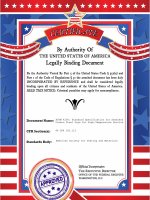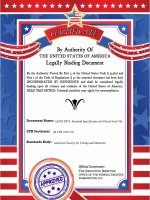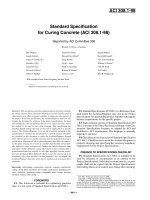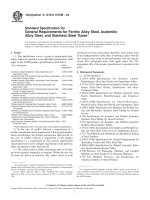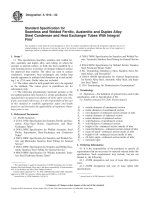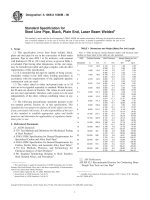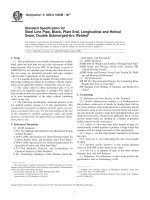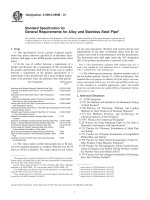ASTM D12-88(1998) Standard Specification for Raw Tung Oil (Withdrawn 2007)
Bạn đang xem bản rút gọn của tài liệu. Xem và tải ngay bản đầy đủ của tài liệu tại đây (21.14 KB, 1 trang )
Designation: D 12 – 88 (Reapproved 1998)
AMERICAN SOCIETY FOR TESTING AND MATERIALS
100 Barr Harbor Dr., West Conshohocken, PA 19428
Reprinted from the Annual Book of ASTM Standards. Copyright ASTM
Standard Specification for
Raw Tung Oil1
This standard is issued under the fixed designation D 12; the number immediately following the designation indicates the year of original
adoption or, in the case of revision, the year of last revision. A number in parentheses indicates the year of last reapproval. A superscript
epsilon (e) indicates an editorial change since the last revision or reapproval.
1. Scope D 2090 Test Method for Clarity and Cleanness of Paint and
Ink Liquids3
1.1 This specification covers raw tung oil derived from
Aleurites fordii Hemsley. D 3278 Test Methods for Flash Point of Liquids by Small
Scale Closed-Cup Apparatus4
2. Referenced Documents
3. Properties
2.1 ASTM Standards:
D 93 Test Methods for Flash Point by Pensky-Martens 3.1 Raw tung oil shall conform to the requirements given in
Table 1 .
Closed Tester2
D 555 Guide for Testing Drying Oils3 TABLE 1 Properties of Raw Tung OilA
D 1466 Test Method for Sampling Liquid Oils and Fatty
Requirements ASTM
Acids Commonly Used in Paints, Varnishes, and Related Test
Materials3 Method
D 1541 Test Method for Total Iodine Value of Drying Oils
and Their Derivatives3 Specific gravity, 25/25°C 0.933 to 0.938 D 1963
D 1544 Test Method for Color of Transparent Liquids Acid value, max 5.0 D 1639
(Gardner Color Scale)4 Saponification value 189 to 195 D 1962
D 1639 Test Method for Acid Value of Organic Coating Unsaponifiable matter, max, % 0.75 D 1965
Materials3 Iodine value (Wijs), min 163 D 1959
D 1955 Test Method for Gel Time of Drying Oils3 Total iodine value, min 220 D 1541
D 1959 Test Method for Iodine Value of Drying Oils and Clarity clear and transparent D 2090
Fatty Acids3
D 1962 Test Method for Saponification Value of Drying Color (Gardner), max at 25°C D 1544
Oils, Fatty Acids, and Polymerized Fatty Acids3 Flash point, min 12 D 3278B
D 1963 Test Method for Specific Gravity of Drying Oils, 203°F (95°C) D 93
Varnishes, Resins, and Related Materials at 25/25°C3 Gel time, minutes, max 250°F (121°C) D 1955
D 1964 Test Method for Tung Oil Quality3 Tung oil quality test 12 D 1964
D 1965 Test Method for Unsaponifiable Matter in Drying Refractive index, 25°C pass
Oils, Fatty Acids, and Polymerized Fatty Acids3 1.5160 to 1.5200
1 This specification is under the jurisdiction of ASTM Committee D-1 on Paint AA relationship between refractive index and tung oil adulteration with other oils
and Related Coatings, Materials, and Applications and is the direct responsibility of is described in “Paint Testing Manual,” Gardner-Sward-13th Edition, 1972, Chapter
Subcommittee D01.32 on Drying Oils. 2.1, Section 12.1, p. 62.
Current edition approved Oct. 31, 1988. Published December 1988. Originally BTest Methods D 3278 are useful only at temperatures up to 230°F, but may be
published as D 12 – 15 T. Last previous edition D 12 – 87. used to test for the presence of volatile solvents as evidenced by a flash point of
230°F or lower.
2 Annual Book of ASTM Standards, Vol 05.01.
3 Annual Book of ASTM Standards, Vol 06.03. 4. Test Methods
4 Annual Book of ASTM Standards, Vol 06.01.
4.1 Sampling—Sampling shall be conducted in accordance
with Test Method D 1466.
4.2 The significance of the test methods enumerated under
properties in this specification is discussed in Guide D 555.
5. Keywords
5.1 drying oils; tung oil
The American Society for Testing and Materials takes no position respecting the validity of any patent rights asserted in connection
with any item mentioned in this standard. Users of this standard are expressly advised that determination of the validity of any such
patent rights, and the risk of infringement of such rights, are entirely their own responsibility.
This standard is subject to revision at any time by the responsible technical committee and must be reviewed every five years and
if not revised, either reapproved or withdrawn. Your comments are invited either for revision of this standard or for additional standards
and should be addressed to ASTM Headquarters. Your comments will receive careful consideration at a meeting of the responsible
technical committee, which you may attend. If you feel that your comments have not received a fair hearing you should make your
views known to the ASTM Committee on Standards, 100 Barr Harbor Drive, West Conshohocken, PA 19428.
1
